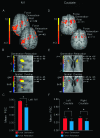Cortical and subcortical mechanisms for precisely controlled force generation and force relaxation
- PMID: 19254959
- PMCID: PMC2758679
- DOI: 10.1093/cercor/bhp015
Cortical and subcortical mechanisms for precisely controlled force generation and force relaxation
Abstract
Gripping objects during everyday manual tasks requires the coordination of muscle contractions and muscle relaxations. The vast majority of studies have focused on muscle contractions. Although previous work has examined the motor cortex during muscle relaxation, the role of brain areas beyond motor cortex remains to be elucidated. The present study used functional magnetic resonance imaging to directly compare slow and precisely controlled force generation and force relaxation in humans. Contralateral primary motor cortex and bilateral caudate nucleus had greater activity during force generation compared with force relaxation. Conversely, right dorsolateral prefrontal cortex (DLPFC) had greater activity while relaxing force compared with generating force. Also, anterior cingulate cortex had greater deactivation while relaxing force compared with generating force. These findings were further strengthened by the fact that force output parameters such as the amplitude, rate, duration, variability, and error did not affect the brain imaging findings. These results demonstrate that the neural mechanisms underlying slow and precisely controlled force relaxation differ across prefrontal-striatal and motor cortical-striatal circuits. Moreover, this study demonstrates that the DLPFC is not only involved in slow and precisely controlled force generation, but has greater involvement in regulating slow and precisely controlled muscle relaxation.
Figures




References
-
- Anderson JR, Qin Y, Jung KJ, Carter CS. Information-processing modules and their relative modality specificity. Cogn Psychol. 2007;54:185–217. - PubMed
-
- Bonnard M, Gallea C, De Graaf JB, Pailhous J. Corticospinal control of the thumb-index grip depends on precision of force control: a transcranial magnetic stimulation and functional magnetic resonance imagery study in humans. Eur J Neurosci. 2007;25:872–880. - PubMed
-
- Corcos DM, Chen CM, Quinn NP, McAuley J, Rothwell JC. Strength in Parkinson's disease: relationship to rate of force generation and clinical status. Ann Neurol. 1996;39:79–88. - PubMed
Publication types
MeSH terms
Grants and funding
LinkOut - more resources
Full Text Sources
Medical

